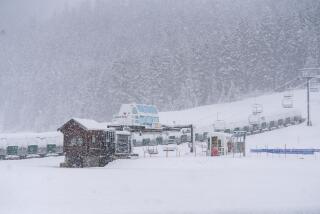Drafted into that wintertime chain gang
- Share via
Your fingers are Popsicles as they fumble with the unfamiliar links of steel, your back melding into the slab of snow it’s propped against, as winter’s low light makes it difficult to see the task at hand.
A winter belay on El Capitan? A brave rescue off an icy couloir? Not quite. The scene is an icy mountain pass through which you must drive to reach your snow-play destination. Tire chains required.
One of the unpleasant inevitabilities of mountain travel in winter is that it often means driving through a lot of snow. As a result, Caltrans and the California Highway Patrol sometimes require motorists -- even those with four-wheel drives -- on certain routes to have snow tires or tire chains on their vehicles.
Snow tires are usually unnecessary in the flats of Southern California. That leaves chains -- the bane of dads and husbands and other menfolk who are often the ones who get stuck peering up at their vehicle’s underbelly installing the devilish tangles of steel.
Chains give tires extra leverage by grabbing onto ice and snow. “They provide more traction points,” says Jeff Spring, a spokesman for the American Automobile Assn. “Wheels spin snow into a glaze, and chains break through that.”
The strength of the chain’s grip depends on the type used. Steel-link chains provide the most, but tend to be heavier than cable chains and can be more difficult to install. By comparison, cable styles are a cinch to put on, are lighter and usually cost less. Newer “Z” cables zigzag across the tire, providing better traction than cables with traditional ladder patterns.
So why bother with cable chains? Many contemporary cars have too little room between the tire and the body to accommodate link chains. A quick check of the owners manual will determine whether your vehicle is one of these -- they are labeled “Class S” by the Society of Automobile Engineers and require chains with a lower profile that hug close to a tire’s surface.
Another option for Class S vehicles is diamond-style link chains (such as those sold by tirechains.com), which have a thinner profile than conventional link chains. Tirechain.com’s sell for $63 for a car, $95 for an SUV. Chains usually can’t be rented; occasionally stores will give buyers a refund if chains go unused. Kragen Auto Parts and Pep Boys sell cable and link chains for about $32 to $85.
The key to installing chains correctly is patience and practice. Always give them a trial run by putting them on at home in the driveway. Incorrectly installed chains can wreak havoc on your car. For example, loose chains can wrap around and snap an axle -- not the recommended way to break in the new Lexus SUV. It’s also a good idea to have work gloves, a headlamp and a tarp to kneel on.
Once chains are installed, stay under 30 mph and off bare pavement, which could extend the life of the chains by as much as 50%.
How do you know when to put on chains? On popular routes, such as the roads leading to Big Bear or Highway 395 to Mammoth, a California Highway Patrol officer will be standing on the road prohibiting passage without chains. Caltrans also flashes signs indicating the type of chain-control areas ahead. R1 conditions -- the least severe -- require chains on all vehicles without snow tires. R2 requires chains on all except four-wheel-drive vehicles with snow tires on all wheels. Chains are required on all vehicles during R3 conditions. (For road conditions, call Caltrans at [800] 427-ROAD.)
It might cost you another $20 plus a five-buck tip, but you could leave the dirty work to “chain monkeys,” self-employed roadside installers who seem to magically appear during snowstorms.
To e-mail Julie Sheer or read her previous Outdoors Institute columns, go to latimes.com/juliesheer.
